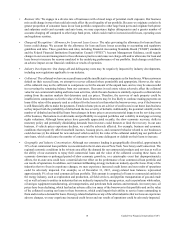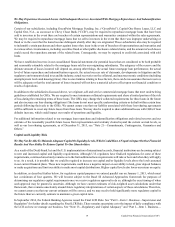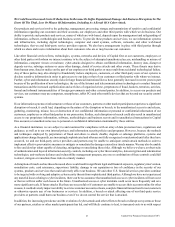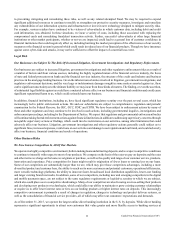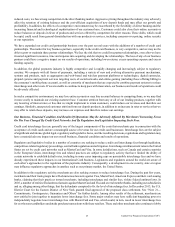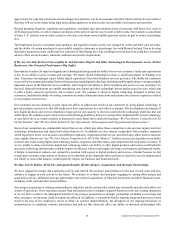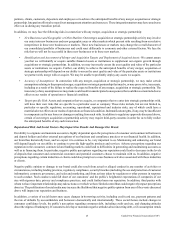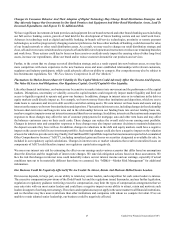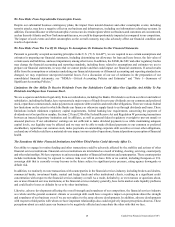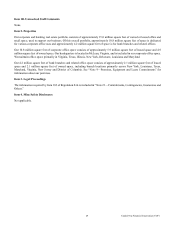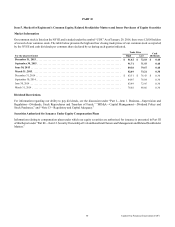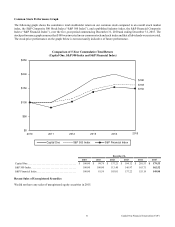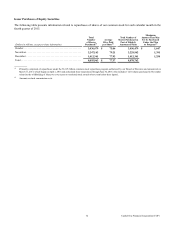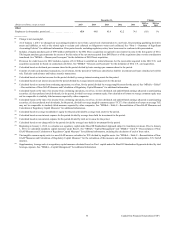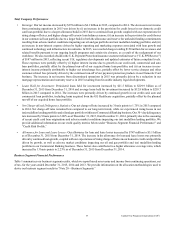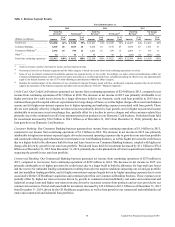Capital One 2015 Annual Report Download - page 47
Download and view the complete annual report
Please find page 47 of the 2015 Capital One annual report below. You can navigate through the pages in the report by either clicking on the pages listed below, or by using the keyword search tool below to find specific information within the annual report.28 Capital One Financial Corporation (COF)
We Face Risks From Unpredictable Catastrophic Events.
Despite our substantial business contingency plans, the impact from natural disasters and other catastrophic events, including
terrorist attacks, may have a negative effect on our business and infrastructure, including our information technology systems. In
addition, if a natural disaster or other catastrophic event occurs in certain regions where our business and customers are concentrated,
such as the mid-Atlantic and New York metropolitan area, we could be disproportionately impacted as compared to our competitors.
The impact of such events and other catastrophes on the overall economy may also adversely affect our financial condition and
results of operations.
We Face Risks From The Use Of Or Changes To Assumptions Or Estimates In Our Financial Statements.
Pursuant to generally accepted accounting principles in the U.S. (“U.S. GAAP”), we are required to use certain assumptions and
estimates in preparing our financial statements, including determining our allowance for loan and lease losses, the fair value of
certain assets and liabilities, and asset impairment, among other items. In addition, the FASB, the SEC and other regulatory bodies
may change the financial accounting and reporting standards, including those related to assumptions and estimates we use to
prepare our financial statements, in ways that we cannot predict and that could impact our financial statements. If actual results
differ from the assumptions or estimates underlying our financial statements or if financial accounting and reporting standards are
changed, we may experience unexpected material losses. For a discussion of our use of estimates in the preparation of our
consolidated financial statements, see “MD&A—Critical Accounting Policies and Estimates” and “Note 1—Summary of
Significant Accounting Policies.”
Limitations On Our Ability To Receive Dividends From Our Subsidiaries Could Affect Our Liquidity And Ability To Pay
Dividends And Repurchase Common Stock.
We are a separate and distinct legal entity from our subsidiaries, including the Banks. Dividends to us from our direct and indirect
subsidiaries, including the Banks, have represented a major source of funds for us to pay dividends on our common and preferred
stock, repurchase common stock, make payments on corporate debt securities and meet other obligations. There are various federal
law limitations on the extent to which the Banks can finance or otherwise supply funds to us through dividends and loans. These
limitations include minimum regulatory capital requirements, federal banking law requirements concerning the payment of
dividends out of net profits or surplus, Sections 23A and 23B of the Federal Reserve Act and Regulation W governing transactions
between an insured depository institution and its affiliates, as well as general federal regulatory oversight to prevent unsafe or
unsound practices. If our subsidiaries’ earnings are not sufficient to make dividend payments to us while maintaining adequate
capital levels, our liquidity may be affected and we may not be able to make dividend payments to our common or preferred
stockholders, repurchase our common stock, make payments on outstanding corporate debt securities or meet other obligations,
each and any of which could have a material adverse impact on our results of operations, financial position or perception of financial
health.
The Soundness Of Other Financial Institutions And Other Third Parties Could Adversely Affect Us.
Our ability to engage in routine funding and other transactions could be adversely affected by the stability and actions of other
financial services institutions. Financial services institutions are interrelated as a result of trading, clearing, servicing, counterparty
and other relationships. We have exposure to an increasing number of financial institutions and counterparties. These counterparties
include institutions that may be exposed to various risks over which we have little or no control, including European or U.S.
sovereign debt that is currently or may become in the future subject to significant price pressure, rating agency downgrade or
default risk.
In addition, we routinely execute transactions with counterparties in the financial services industry, including brokers and dealers,
commercial banks, investment banks, mutual and hedge funds and other institutional clients, resulting in a significant credit
concentration with respect to the financial services industry overall. As a result, defaults by, or even rumors or questions about,
one or more financial services institutions, or the financial services industry generally, have led to market-wide liquidity problems
and could lead to losses or defaults by us or by other institutions.
Likewise, adverse developments affecting the overall strength and soundness of our competitors, the financial services industry
as a whole and the general economic climate or sovereign debt could have a negative impact on perceptions about the strength
and soundness of our business even if we are not subject to the same adverse developments. In addition, adverse developments
with respect to third parties with whom we have important relationships also could negatively impact perceptions about us. These
perceptions about us could cause our business to be negatively affected and exacerbate the other risks that we face.


